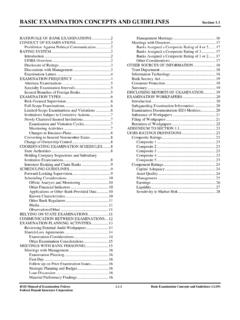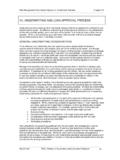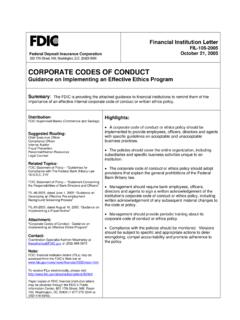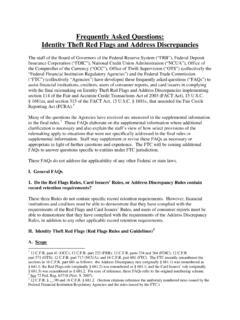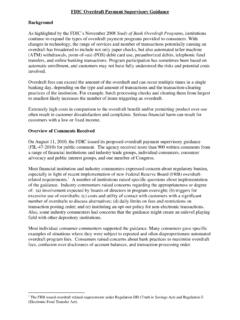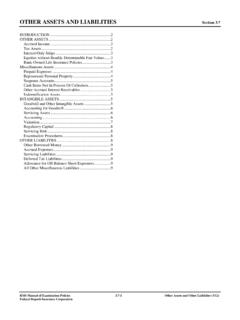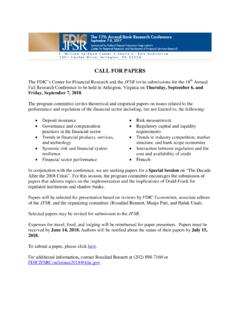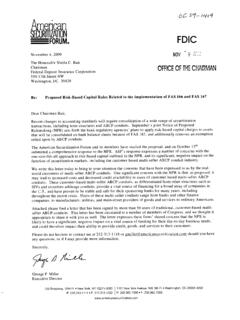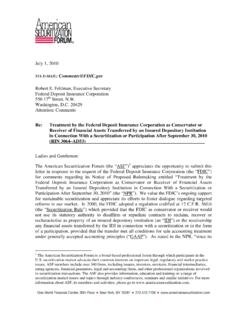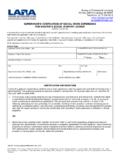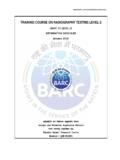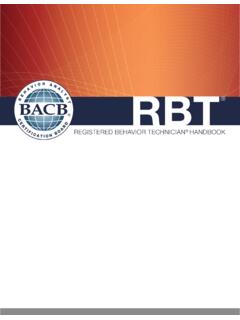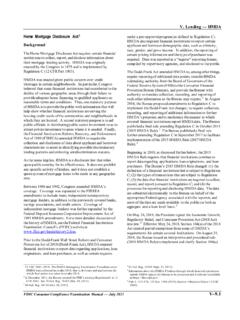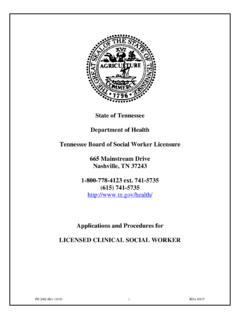Transcription of Laws and Regulations HMDA
1 Laws and Regulations HMDA Examination Procedures March 2019 HMDA 1 Home Mortgage Disclosure Act (HMDA)1 Background The Home Mortgage Disclosure Act requires certain financial institutions to collect, report, and disclose information about their mortgage lending activity. HMDA was originally enacted by the Congress in 1975 and is implemented by Regulation C (12 CFR Part 1003). HMDA was enacted given public concern over credit shortages in certain neighborhoods. In particular, Congress believed that some financial institutions had contributed to the decline of various geographic areas through their failure to provide adequate home financing to qualified applicants on reasonable terms and conditions. Thus, one statutory purpose of HMDA is to provide the public with information that will help show whether financial institutions are serving the housing credit needs of the communities and neighborhoods in which they are located.
2 A second statutory purpose is to aid public officials in distributing public sector investment so as to attract private investment to areas where it is needed. Finally, the Financial Institutions Reform, Recovery, and Enforcement Act of 1989 (FIRREA) amended HMDA to require the collection and disclosure of data about applicant and borrower characteristics to assist in identifying possible discriminatory lending patterns and enforcing antidiscrimination statutes. As the name implies, HMDA is a disclosure law that relies upon public scrutiny for its effectiveness. It does not prohibit any specific activity of lenders, and it does not establish a quota system of mortgage loans to be made in any geographic area. Between 1988 and 1992, Congress amended HMDA s coverage. Coverage was expanded in the FIRREA amendments to include many independent nondepository mortgage lenders, in addition to the previously covered banks, savings associations, and credit unions.
3 Coverage of independent mortgage bankers was further expanded by the Federal Deposit Insurance Corporation Improvement Act of 1991 HMDA amendments. For a more detailed discussion of the history of HMDA, see the Federal Financial Institutions Examination Council s (FFIEC) website at Prior to the Dodd-Frank Wall Street Reform and Consumer Protection Act of 2010 (Dodd-Frank Act), HMDA required financial institutions to report data regarding applications, loan originations, and loan purchases, as well as certain requests under a pre-approval program (as defined in Regulation C). HMDA also required financial institutions to report certain applicant and borrower demographic data, such as ethnicity, race, gender, and gross income. In addition, the reporting of certain pricing information and the type of purchaser was required. Data was reported in a register reporting format, compiled by supervisory agencies, and disclosed to the public.
4 1 12 USC 2801 2810. The HMDA Interagency Examination Procedures cover HMDA data collected in or after 2018, that is, for loans and applications for which final action was taken in or after 2018. Laws and Regulations HMDA Examination Procedures March 2019 HMDA 2 The Dodd-Frank Act amended HMDA to, among other things, require reporting of additional data points, transfer HMDA rulemaking authority from the Board of Governors of the Federal Reserve System (FRB) to the Consumer Financial Protection Bureau (Bureau), and provide the Bureau with authority to mandate collection, recording, and reporting of such other information as the Bureau may In August 2014, the Bureau proposed amendments to Regulation C to implement the Dodd-Frank Act changes; to require collection, recording, and reporting of additional information to further HMDA s purposes; and to modernize the manner in which covered financial institutions report HMDA data.
5 The Bureau published a final rule amending Regulation C in October 2015 (2015 HMDA Rule).3 The Bureau published a final rule further amending Regulation C in September 2017 to facilitate implementation of the 2015 HMDA Rule (2017 HMDA Rule).4 Beginning in 2018, as discussed further below, the 2015 HMDA Rule requires that financial institutions continue to report data regarding applications, loan originations, and loan purchases. The Bureau s 2015 HMDA Rule changed: (1) the definition of a financial institution that is subject to Regulation C; (2) the types of transactions that are subject to Regulation C; (3) the data that financial institutions are required to collect, record, and report pursuant to Regulation C; and (4) the processes for reporting and disclosing HMDA data. The data are submitted electronically to the Bureau on behalf of the appropriate Federal agency associated with the reporter, and most of the data are made available to the public on both an aggregate and a loan-level On May 24, 2018, the President signed the Economic Growth, regulatory Relief, and Consumer Protection Act (2018 Act) into Effective May 24, 2018, Section 104(a) of the 2018 Act created partial exemptions from some of HMDA s requirements for certain covered institutions.
6 On August 31, 2018, the Bureau issued an interpretive and procedural rule (2018 HMDA Rule) to implement and clarify Section 104(a) of the 2018 Act (2018 HMDA Rule). The 2018 HMDA Rule was published in the Federal Register on September 7, The Federal supervisory agencies use HMDA data to support a variety of activities. For example, some Federal supervisory agencies use HMDA data as part of their fair lending examination process,8 and other agencies use HMDA data in conducting Community 2 In December 2011, the Bureau restated the FRB s existing Regulation C at 12 CFR 1003. See 76 Fed. Reg. 78465 (Dec. 19, 2011). 3 80 Fed. Reg. 66128 (Oct. 28, 2015). 4 82 Fed. Reg. 43088 (Sept. 13, 2017). 5 Information about the HMDA Platform through which financial institutions submit HMDA data to the Bureau to be processed and disclosed is available at 6 Pub. L. 115-174, 132 Stat.
7 1296 (2018), Section 104(a) (codified at 12 USC 2803). 7 83 Fed. Reg. 45325 (Sept. 7, 2018). 8 15 USC 1691 1691f, 42 USC 3605, and 12 CFR 1002. Laws and Regulations HMDA Examination Procedures March 2019 HMDA 3 Reinvestment Act (CRA) performance Moreover, HMDA disclosures provide the public with information on the home mortgage lending activities of particular reporting entities and on activity in their communities. These disclosures are used by local, State, and Federal officials to evaluate housing trends and issues and by community organizations to monitor financial institution lending patterns. Because HMDA data serve numerous important purposes, validating the accuracy of HMDA data is a key element of the Federal supervisory agencies examination activities. Coverage A. Institutional Coverage Institutional Coverage Generally An institution is required to comply with Regulation C only if it is a financial institution as that term is defined in Regulation C.
8 The definition of financial institution includes both depository financial institutions and nondepository financial institutions, as those terms are separately defined in Regulation C. 12 CFR (g). An institution uses these two definitions, which are outlined below, as coverage tests to determine whether it is a financial institution that is required to comply with Regulation C. For the purpose of these examination procedures, the term financial institution refers to an institution that is either a depository financial institution or a nondepository financial institution that is subject to Regulation C. Institutional Coverage Tests Depository Financial Institutions A bank, savings association, or credit union is a depository financial institution and subject to Regulation C if it meets ALL of the following: 1. Asset-Size Threshold. On the preceding December 31, the bank, savings association, or credit union had assets in excess of the asset-size threshold published annually in the Federal Register, as included in the Official Interpretations, 12 CFR Part 1003, Comment 2(g)-2, and posted on the Bureau s website.
9 12 CFR (g)(1)(i). The phrase preceding December 31 refers to the December 31 immediately preceding the current calendar year. For example, in 2019, the preceding December 31 is December 31, 2018. Comment 2(g)-1. 2. Location Test. On the preceding December 31, the bank, savings association, or credit union had a home or branch office located in a metropolitan statistical area (MSA). 12 CFR (g)(1)(ii). 9 12 USC 2901 2908, and 12 CFR 25, 195, 228, and 345. Laws and Regulations HMDA Examination Procedures March 2019 HMDA 4 For purposes of this location test, a branch office for a bank, savings association, or credit union is an office: (a) of the bank, savings association, or credit union (b) that is considered a branch by the institution s Federal or State supervisory agency.
10 For purposes of Regulation C, an automated teller machine or other free-standing electronic terminal is not a branch office regardless of whether the supervisory agency would consider it a branch. 12 CFR (c)(1). A branch office of a credit union is any office where member accounts are established or loans are made, whether or not a Federal or State agency has approved the office as a branch. Comment 2(c)(1)-1. 3. Loan-Activity Test. During the preceding calendar year, the bank, savings association, or credit union originated at least one home purchase loan or refinancing of a home purchase loan secured by a first lien on a one-to-four-unit dwelling. 12 CFR (g)(1)(iii). For more information on whether a loan is secured by a dwelling, is a home purchase loan, or is a refinancing, see 12 CFR (f), (j), and (p) and associated commentary. 4. Federally Related Test. The bank, savings association, or credit union: a.
